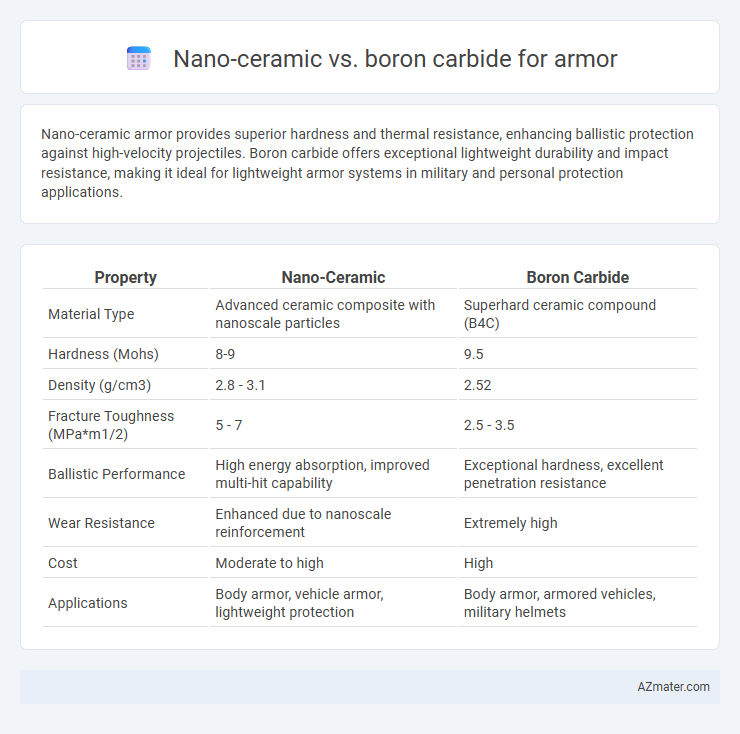Nano-ceramic armor provides superior hardness and thermal resistance, enhancing ballistic protection against high-velocity projectiles. Boron carbide offers exceptional lightweight durability and impact resistance, making it ideal for lightweight armor systems in military and personal protection applications.
Table of Comparison
| Property | Nano-Ceramic | Boron Carbide |
|---|---|---|
| Material Type | Advanced ceramic composite with nanoscale particles | Superhard ceramic compound (B4C) |
| Hardness (Mohs) | 8-9 | 9.5 |
| Density (g/cm3) | 2.8 - 3.1 | 2.52 |
| Fracture Toughness (MPa*m1/2) | 5 - 7 | 2.5 - 3.5 |
| Ballistic Performance | High energy absorption, improved multi-hit capability | Exceptional hardness, excellent penetration resistance |
| Wear Resistance | Enhanced due to nanoscale reinforcement | Extremely high |
| Cost | Moderate to high | High |
| Applications | Body armor, vehicle armor, lightweight protection | Body armor, armored vehicles, military helmets |
Introduction to Advanced Armor Materials
Nano-ceramic and boron carbide represent forefront materials in advanced armor technology, offering exceptional hardness and lightweight protection. Nano-ceramics exhibit enhanced toughness and improved ballistic resistance due to their fine-grained microstructure, while boron carbide remains one of the hardest known ceramics with superior compressive strength and low density. These materials enable the development of next-generation armor systems that enhance survivability without compromising mobility.
Overview of Nano-Ceramic Armor Technology
Nano-ceramic armor technology utilizes engineered nanostructured ceramic materials that significantly enhance hardness and fracture toughness compared to conventional ceramics, leading to superior ballistic protection. The nano-scale grain size in these ceramics improves crack deflection and energy absorption during impact, making them highly effective against high-velocity projectiles. This advanced material technology offers lightweight, durable armor solutions with improved multi-hit capabilities for military and personal protective applications.
Boron Carbide: Properties and Uses in Armor
Boron carbide is an exceptionally hard material, ranking third after diamond and cubic boron nitride, making it a prime choice for armor applications due to its high hardness, low density, and excellent resistance to impact and abrasion. Its ceramic nature allows it to effectively dissipate kinetic energy from projectiles, providing superior ballistic protection in military and personal armor systems compared to nano-ceramic alternatives. Widely used in body armor plates, vehicle armor, and protective helmets, boron carbide balances lightweight properties with toughness, enhancing mobility without sacrificing defense.
Comparative Hardness and Strength
Nano-ceramic materials exhibit exceptional hardness, often exceeding 15 GPa on the Vickers scale, providing excellent ballistic resistance. Boron carbide, one of the hardest known ceramics with a hardness of approximately 29 GPa, offers superior strength-to-weight ratio and impact resistance essential for armor applications. While nano-ceramics provide enhanced toughness and energy absorption, boron carbide delivers unmatched hardness and compressive strength, making it a preferred choice for lightweight, high-performance armor systems.
Weight Considerations: Nano-Ceramic vs. Boron Carbide
Nano-ceramic armor offers a significant weight advantage compared to boron carbide due to its higher strength-to-weight ratio, making it ideal for lightweight ballistic protection. Boron carbide, while slightly heavier, provides exceptional hardness and superior ballistic resistance, often used in multi-hit armor applications where durability is critical. Weight considerations are crucial in armor design, with nano-ceramics enabling thinner, lighter plates without sacrificing protective capabilities, enhancing mobility for wearers in tactical environments.
Ballistic Performance: Stopping Power Analysis
Nano-ceramic armor exhibits exceptional hardness and energy absorption, allowing it to effectively dissipate kinetic energy from high-velocity projectiles. Boron carbide outranks most armor materials due to its unparalleled hardness--nearly 9.5 Mohs--providing superior ballistic resistance against armor-piercing rounds while maintaining lightweight properties. Analysis of stopping power shows boron carbide offers higher crack resistance and shatter toughness compared to nano-ceramic composites, making it the preferred choice for advanced armor applications requiring maximum protection and weight efficiency.
Durability and Longevity of Armor Systems
Nano-ceramic armor exhibits exceptional hardness and impact resistance, offering high durability against ballistic threats and fragmentation. Boron carbide armor, known for its extreme hardness and lightweight properties, provides superior longevity by maintaining structural integrity under repeated impacts and abrasive conditions. The combination of nano-ceramic coatings with boron carbide substrates enhances overall armor system resilience, extending service life and reducing maintenance needs.
Cost Efficiency and Production Scalability
Nano-ceramic armor offers superior cost efficiency due to lower raw material expenses and simpler manufacturing processes compared to boron carbide, which is significantly more expensive and requires complex sintering techniques. Production scalability favors nano-ceramics as they can be produced in larger volumes with consistent quality using established industrial methods, while boron carbide's brittle nature and intricate fabrication limit mass production capabilities. Evaluating lifecycle costs and manufacturing throughput positions nano-ceramic as a more economically sustainable choice for widespread armor applications.
Application Suitability: Military and Civilian Use
Nano-ceramic materials provide exceptional hardness and lightweight properties ideal for personal body armor and vehicle protection in military applications, offering enhanced ballistic resistance against rifle rounds and shrapnel. Boron carbide excels in both military armor and civilian industries like aerospace and nuclear sectors due to its superior hardness and neutron absorption capabilities, making it suitable for multi-threat protection including armor-piercing rounds and radiation shielding. The choice between nano-ceramic and boron carbide depends on specific operational requirements, balancing weight, durability, and threat level for optimal defense in diverse environments.
Future Trends in Armor Material Development
Nano-ceramic materials exhibit exceptional hardness and thermal stability, making them prime candidates for next-generation lightweight armor systems, while boron carbide remains a benchmark due to its high hardness-to-weight ratio and impact resistance. Emerging research focuses on hybrid composites combining nano-ceramics with boron carbide to enhance multi-threat protection capabilities and reduce overall armor weight without compromising performance. Advanced manufacturing techniques like additive manufacturing and nanostructuring are accelerating the development of these materials, promising enhanced durability, flexibility, and scalability in future armor solutions.

Infographic: Nano-ceramic vs Boron carbide for Armor
 azmater.com
azmater.com